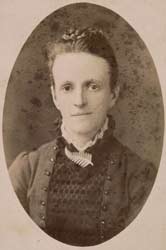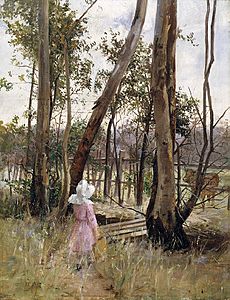Jane Sutherland facts for kids
Quick facts for kids
Jane Sutherland
|
|
|---|---|
 |
|
| Born | 16 December 1853 New York City, USA
|
| Died | 5 July 1928 (aged 74) Melbourne, Australia
|
| Nationality | Australian |
| Known for | Painting |
| Movement | Heidelberg School |
Jane Sutherland (born December 26, 1853 – died July 25, 1928) was an important Australian landscape painter. She was a key member of the Heidelberg School, a group of artists who loved painting outdoors. Jane also worked hard to help other women artists get the recognition they deserved in the late 1800s.
Contents
Early Life and Art Training
Jane Sutherland was born in New York City, USA. Her parents were from Scotland. In 1864, her family moved to Sydney, Australia. Then, in 1870, they settled in Melbourne. The Sutherland family quickly became important to Melbourne's growing art scene.
It was unusual at the time, but Jane's family strongly supported her dream of becoming an artist. Because of their support, Jane could live comfortably as an unmarried working woman.
In the late 1800s, there were different ideas about women's education. Some people believed a woman's main role was to be a mother. But the Australian women's suffrage movement fought for equal education. They believed women needed education to gain confidence, achieve goals, and find jobs. This included studying visual arts.
Slowly, women were allowed into the National Gallery School. Jane Sutherland was brave and enrolled there as early as 1871. This was 14 years before the Women's Suffrage Society even started in Melbourne! Studying art was seen as a good hobby for upper-class women. However, it was much harder for female artists to be paid and respected as much as male artists.
A Career in Art
From 1878, Jane Sutherland showed her art at many exhibitions. She exhibited with the Victorian Academy of Arts and later with the Victorian Artists’ Society until 1911. People at the time thought highly of her art. Critics reviewed her work just like they reviewed male artists' work. They didn't just group her with other "lady artists." This showed how much her landscapes were respected.
In 1884, Jane became one of the first women to join the Buonarotti Club. This club helped artists like Jane, Tom Roberts, and others become friends. They started painting together outdoors, which was how the Heidelberg School began.
Jane Sutherland was the most important female artist in this group of Melbourne painters. They loved to paint outside the studio, a style called plein-air. She went on sketching trips to places like Alphington, Templestowe, and Box Hill. These trips were with her male friends from the Heidelberg School.
However, unlike male artists such as Tom Roberts or Arthur Streeton, Jane could not stay overnight at the campsites. As a woman, she had to travel to the campsites each day.
From 1888, Jane shared an art studio with another artist, Clara Southern. Their studio was at Grosvenor Chambers in Collins Street, Melbourne. This place became a hub for the Heidelberg School artists.
Jane Sutherland and Clara Southern both created artworks for the 9 by 5 Impression Exhibition in Melbourne in 1889. This exhibition showed many works by the Heidelberg School artists. It is seen as the start of Australian Impressionism. However, Jane's and Clara's works were not shown. Art historians still debate if this was because they were women or if their art just didn't fit the exhibition's theme.
In 1900, Jane Sutherland and May Vale were the first women elected as Councillors of the Victorian Artists’ Society. During her active years, she was highly valued for her contributions to Melbourne's art scene.
Most of Jane Sutherland's paintings show Australian landscapes. She often included women and children interacting with nature. Her paintings suggest a story, but her figures often turn away from the viewer.
Even with her success, Jane found it hard to be seen as a serious professional artist. She was forced to sell her paintings for much less than male artists. For example, in an 1894 exhibition, her painting To the Dandenong was priced at eighteen guineas. But David Davies sold his painting Moonrise for seventy-five pounds.
Later Years and Legacy
In the early 1900s, Jane Sutherland had a serious stroke. After this, she relied completely on her brother, William Sutherland, for care. With William's help, Jane was able to keep painting and showing her work. She also taught art to new students. However, her illness meant her paintings became smaller, changing from large canvases to small pastels.
After William's death in 1911, Jane had to stop painting. She retired and lived until 1928. Because she could no longer paint, people slowly forgot about her. By the time she passed away on July 28, there was little public notice of her death.
Jane Sutherland was a very important artist. She was part of a generation of Australian women who chose art careers over marriage and family. Her niece, Ruth Sutherland, also became a painter. While we don't know much about Jane's personality, her art is now in national museums. This allows people to continue to study and understand her work.
A street in Canberra, Australia, called Jane Sutherland Circuit, is named in her honor.
Awards
- Wallen Prize, National Gallery School, Annual Students’ Exhibition, 1883
Where Her Art Is Displayed
- Art Gallery of South Australia
- Ballarat Fine Art Gallery
- LaTrobe Library Picture Collection
- National Gallery of Australia
- National Gallery of Victoria
- Newcastle Region Art Gallery
- Northern Territory Museum and Art Gallery
- State Library of Victoria, Melbourne
- University of Melbourne Art Museum
Images for kids







